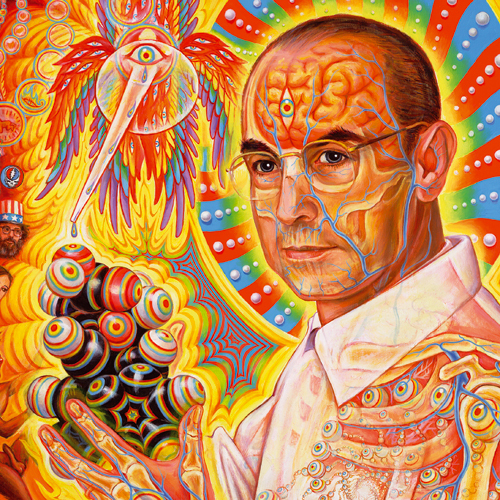A Long Strange Trip...
Part One

There's a lot of things I haven't tried, and a lot that I don't intend to. Stuff like crystal meth isn't interesting, in any way. That's why there's going to be a lot of psychedelic entries. I find these the most interesting. They're so weird. Anyway, starting off with a personal favorite...
LSD.
Lysergic acid diethylamide, or just acid, is in my humble opinion, THE psychedelic drug. Made immortal over the years in music, film, literature, and counterculture. We've all read about Hunter S. Thompson's adventures, we've all read about Ken Kesey and the Merry Pranksters, LSD can be found in countless items of media. And of course we all know about th 1960s acid wave, the hippies, the Summer of Love, Woodstock. All that back in the day, when acid wasn't sold for profit, but distributed among the population. These psychedelic experiences brought about peace and love and understanding, we believed that they were beneficial to life, bringing us closer to true enlightenment. Opening doors we didn't even know existed.It was changing lives, causing breakthroughs in the mind and mystical/religious experiences. In this time, LSD users were split into two groups. The first believed it was too powerful, and that it should only be disributed to those viewed as elite, this ideal was one that was advocated by Aldous Huxley (
The Doors of Perception). The second grup was more casual. During the 1960s, casual LSD users evolved and expanded into a subculture that extolled the mystical and religious symbolism often engendered by the drug's powerful effects, and advocated its use as a method of raising consciousness.
A Brief History
LSD was synthesized by Albert Hoffman in 1938 from chemicals found in ergot, a fungus that grows on rye bread. Hoffman was studying ergot for further use in pharmaceuticals, and while researching lysergic acid derivatives found from the ergot chemicals, LSD was synthesized. His original intention was for that of a circulatory stimulant. He set aside his doscovery for five years before looking at it again. He began to re-synthesize it, and absorbed some accidentally through his fingertips. This is where LSD's effects were first noted.
Quote:
|
Originally Posted by Albert Hoffman
... affected by a remarkable restlessness, combined with a slight dizziness. At home I lay down and sank into a not unpleasant intoxicated-like condition, characterized by an extremely stimulated imagination. In a dreamlike state, with eyes closed (I found the daylight to be unpleasantly glaring), I perceived an uninterrupted stream of fantastic pictures, extraordinary shapes with intense, kaleidoscopic play of colors. some two hours this condition faded away.
|
Three days later, April 19, 1943, he experiments more with LSD, this time intentionally ingesting 250 micrograms. He felt similar effects as before, and had to be excorted home by bicycle. April 19 is now known as "Bicycle Day", marking the first true acid trip, and an important discovery.
Brought to the attention of the US, LSD began being used in psychiatrics. Researchers used it to produce model psychosis, a temporary state of mental illness. After a pleasurable experience by Sidney Cohen, scientists began looking at LSD as having helpful effects in facilitating psychotherapy, increasing creativity, and even curing alcoholism. By the late 50s, unlicensed therapists were administering LSD to their patients. LSD was also given to alcoholics in AA, and after a year, 50% of the group had not had a single drink, a success rate that has never been duplicated by any other means.
Basically, positive uses of LSD were popping up everywhere, usually with success. But by the mid-sixties the backlash against the use of LSD and its perceived corrosive effects on the values of the Western middle class resulted in governmental action to restrict the availability of the drug by making any use of it illegal. It became a schedule 1 drug, "high potential for abuse". LSD became illegal in California on October 6, 1966. Other U.S. states and the rest of the world followed with the ban. Even so, recreational use had been increasing.